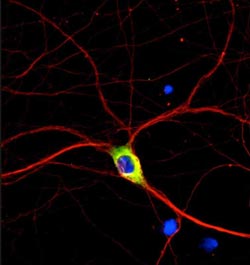Molecular knock-out alleviates Alzheimer’s symptoms in mice

The HDAC6 protein (green) regulates the transportation of mitochondria – the cell’s power plants – along ‘microtubule highways’ (red) inside nerve cells (nucleus shown in blue). This process is inhibited in Alzheimer’s nerve cells and can be returned to normal by switching off HDAC6.<br>Source: André Fischer<br>
Researchers at the German Center for Neurodegenerative Diseases (DZNE) and the University Medical Center Göttingen (UMG) have identified an enzyme as a possible target for the treatment of Alzheimer’s disease. The protein known as HDAC6 impairs transport processes within the nerve cells. The scientists observed only mild symptoms of the disease in mice if the enzyme was not produced. They propose to block its activity in a targeted fashion to treat the disease.
Scientists from the DZNE sites in Göttingen and Bonn, the UMG as well as from the US participated in this basic research project on Alzheimer’s disease. The study is published in “EMBO Molecular Medicine”.
The researchers led by Prof. André Fischer, Department of Psychiatry and Psychotherapy at the University Medical Center Gottingen and Site Speaker of the DZNE in Göttingen, investigated mice with a modified genetic background. The animals showed behavioural disorders and brain deposits that are typically associated with Alzheimer’s disease. The researchers went a step further with a group of other animals by removing the genes responsible for the production of the HDAC6 enzyme (histone deacetylase 6). This intervention proved to be effective: while these mice also exhibited the pathological features of Alzheimer’s disease in the brain, their behaviour was significantly ameliorated. “The animals’ ability to learn and to find their spatial bearings was relatively normal”, says Prof. Fischer. “Their cognitive abilities were fully comparable to those of healthy mice.”
Improved cellular traffic
In the researchers’ view, this effect is at least partly attributable to the fact that important transport processes within the nerve cells are facilitated when the HDAC6 enzyme is not around. This meant in particular that the cells’ power plants, also known as “mitochondria”, can travel to their final destinations. “It is known that in various neurodegenerative diseases cellular transport is no longer functional. The substances that are to be transported along axons are left behind”, Fischer says. “Measures which improve trafficking seem to have a positive effect.”
Possible target for therapy?
The researchers’ findings suggest that the HDAC6 enzyme could be a possible target for therapies against Alzheimer’s disease. However, treatments would require an active substance that can disable the enzyme in a targeted fashion. Unfortunately, the active substances known to date are too unspecific. Prof. Fischer explains that their application resembles a broad-spectrum treatment: “We don’t know precisely what is the therapeutic effect of the inhibitors, since they simultaneously block several enzymes from the histone deacetylase family”, he says. “And we still don’t know enough about how the individual enzymes function”.
Improving the accuracy of the inhibitors is therefore the aim of further research. “We will continue to work toward this goal. On one hand, we want to improve our understanding of how the various histone deacetylases function. On the other hand, we want to test inhibitors that operate in a more targeted manner”, says Prof. André Fischer.
Original publication:
“Reducing HDAC6 ameliorates cognitive deficits in a mouse model for Alzheimer’s disease”, Nambirajan Govindarajan, Pooja Rao, Susanne Burkhardt, Farahnaz Sananbenesi, Oliver M. Schlüter, Frank Bradke, Jianrong Lu, André Fischer, EMBO Molecular Medicine, online at: http://onlinelibrary.wiley.com/doi/10.1002/emmm.201201923/abstract
The German Center for Neurodegenerative Diseases (DZNE) investigates the causes of diseases of the nervous system and develops strategies for prevention, treatment and care. It is an institution of the Helmholtz Association of German Research Centres with sites in Berlin, Bonn, Dresden, Göttingen, Magdeburg, Munich, Rostock/Greifswald, Tübingen and Witten. The DZNE cooperates closely with universities, their clinics and other research facilities. Its cooperation partners in Göttingen are the Georg-August-University and the University Medical Center Göttingen. Website: http://www.dzne.de/en
Media Contact
More Information:
http://www.dzne.de/enAll latest news from the category: Life Sciences and Chemistry
Articles and reports from the Life Sciences and chemistry area deal with applied and basic research into modern biology, chemistry and human medicine.
Valuable information can be found on a range of life sciences fields including bacteriology, biochemistry, bionics, bioinformatics, biophysics, biotechnology, genetics, geobotany, human biology, marine biology, microbiology, molecular biology, cellular biology, zoology, bioinorganic chemistry, microchemistry and environmental chemistry.
Newest articles

Properties of new materials for microchips
… can now be measured well. Reseachers of Delft University of Technology demonstrated measuring performance properties of ultrathin silicon membranes. Making ever smaller and more powerful chips requires new ultrathin…

Floating solar’s potential
… to support sustainable development by addressing climate, water, and energy goals holistically. A new study published this week in Nature Energy raises the potential for floating solar photovoltaics (FPV)…

Skyrmions move at record speeds
… a step towards the computing of the future. An international research team led by scientists from the CNRS1 has discovered that the magnetic nanobubbles2 known as skyrmions can be…





















